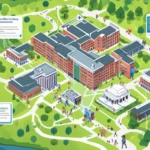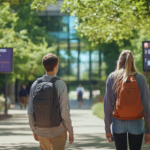Enhance your campus communication by using digital screens for real-time event updates. These screens provide immediate alerts about event changes, critical notifications, and emergency guidance. Utilizing engaging, dynamic content boosts participation and recall rates. Cloud-based management allows you to update screens instantly from a centralized system, ensuring consistent and accurate information. Interactive touchscreens and QR codes enhance user engagement, while sustainable practices support eco-friendly initiatives. Optimize navigation and event coordination with seamless, real-time updates. Use role-based permissions to maintain content accuracy. Want to know how to integrate these effectively on your campus? Keep exploring our insights.
Key Takeaways
- Real-time updates ensure accurate event information across all campus digital screens.
- Digital screens positioned strategically enhance campus safety and organization.
- Cloud-based management allows efficient content updates and distribution.
- Touchscreen and QR codes on screens facilitate direct engagement with event details.
- Dynamic and interactive content increases student engagement by up to 400%.
Real-Time Event Alerts
Real-time event alerts on digital screens guarantee you receive immediate updates about important campus events and changes. These screens ensure the immediate dissemination of critical information, whether it’s a sudden event cancellation or a last-minute venue change. By broadcasting these updates in real-time, digital screens greatly enhance campus safety. For instance, emergency notifications can be promptly displayed, guiding you and others to the appropriate resources during pivotal situations.
You can rely on these real-time alerts to stay informed about any alterations in scheduled events, reducing confusion and ensuring you’re always in the loop. Digital screens positioned strategically across the campus facilitate this immediate flow of information, making it easier for everyone to stay updated without delay. This efficient communication method not only boosts event attendance but also encourages greater participation by keeping everyone well-informed.
In emergency situations, these screens become crucial tools. They display prominent notifications, ensuring that safety procedures and critical information reach you without delay. The real-time nature of these alerts means you’ll always have the most up-to-date information, essential for maintaining a safe and well-organized campus environment.
Engaging Dynamic Content
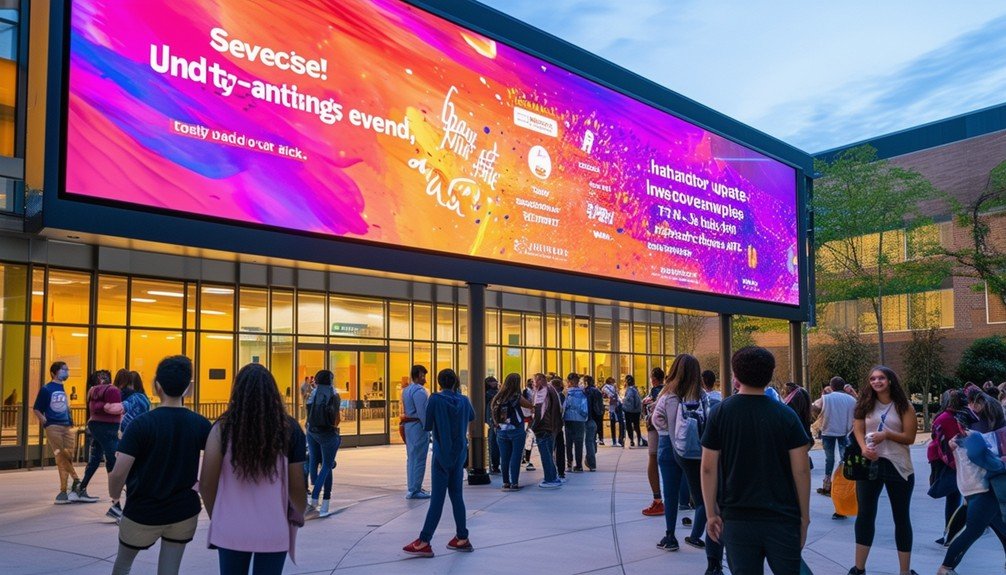
You can boost engagement by incorporating real-time data integration, making event announcements interactive, and highlighting social media content. These features keep the information relevant and exciting for your audience. Trust and interest grow as students interact with dynamic and up-to-date content.
Real-Time Data Integration
Leveraging real-time data integration on digital screens guarantees that attendees receive up-to-the-minute information, making events more engaging and dynamic. By incorporating real-time data integration, you can facilitate dynamic content updates that keep your audience informed about the latest event details, schedules, and any changes. Interactive displays become powerful tools in this setup, showcasing live updates and engaging attendees more effectively.
Utilizing social media feeds on these digital screens can further enhance audience engagement. Attendees can view live social media posts related to the event, fostering a sense of community and participation. This not only keeps the content fresh but also encourages attendees to interact and share their experiences online.
Event management systems play an essential role in this process as they allow seamless integration of various data sources. These systems ensure that all updates, whether changes in event schedules or new announcements, are immediately reflected on the digital screens. This real-time information flow keeps your event running smoothly and allows attendees to stay informed without any delays.
Incorporating real-time data integration and dynamic content updates ensures that your campus events are not only informative but also highly engaging and interactive for all attendees.
Interactive Event Announcements
Interactive event announcements on digital screens captivate audiences by offering engaging, dynamic content that transforms how event details are communicated. When you employ interactive elements in your event announcements, engagement can increase by up to 400% compared to static media. This significant boost in attention guarantees your messages reach and resonate with students and staff effectively.
Digital screens displaying dynamic content not only capture attention but also improve recall rates. By integrating varying layouts and interactive features, you keep the information fresh and interesting, which enhances the overall experience for viewers. Real-time updates guarantee that the event information displayed is always accurate and up-to-date, reducing the likelihood of confusion or missed opportunities.
Interactive features, such as touchscreens or QR codes, allow viewers to engage directly with the content. This engagement transforms passive viewers into active participants, fostering a deeper connection with the event details. Whether it’s exploring more information, signing up for events, or sharing the announcements with others, interactive digital screens make event communication more effective and memorable.
Social Media Highlights
Incorporating social media highlights on digital screens increases student engagement by 45%, transforming passive viewers into active participants. By featuring real-time social media feeds, you can showcase student-generated content that boosts campus community involvement. Displaying dynamic updates about college events, clubs, and activities on these screens drives participation and keeps everyone informed.
Interactive social media displays are particularly effective, allowing students to interact with posts and even share their own content. This creates a sense of community and connectivity, as students see their contributions highlighted across campus. Utilizing trending hashtags and promoting campus social media accounts on digital screens can further enhance this connectivity.
Here’s a quick look at how social media highlights can be integrated effectively:
| Feature | Benefit |
|---|---|
| Real-time feeds | Immediate updates, increased relevance |
| Student-generated content | Higher engagement, community building |
| Event and activity updates | Increased participation |
| Interactive displays | Active student involvement |
Cloud-Based Management
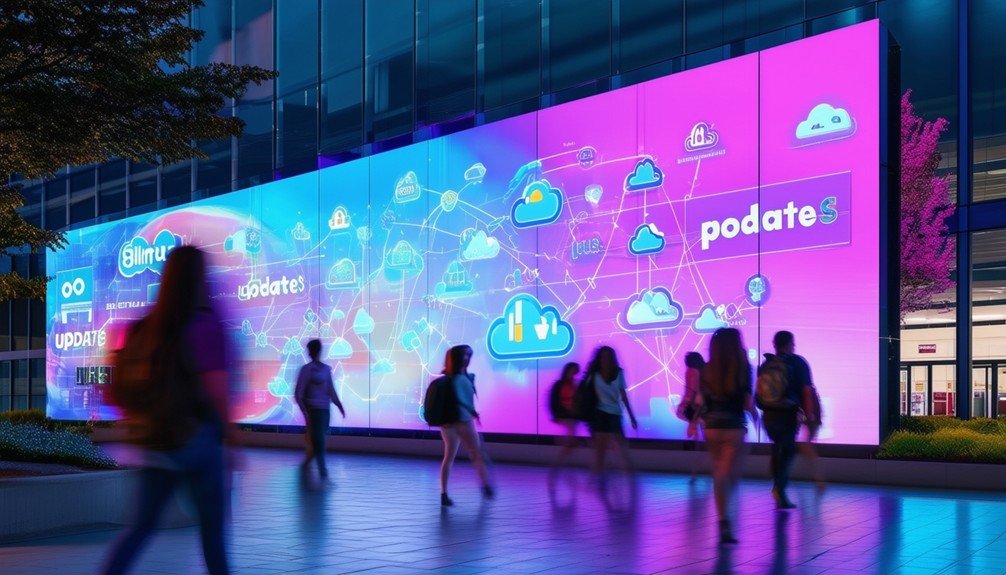
Cloud-hosted digital signage management allows you to effortlessly control and update screens across the campus from any web browser. By leveraging cloud-hosted digital solutions, you can achieve real-time updates, making sure that your content is always current and relevant. This approach utilizes a centralized control system and a robust content management system, making it simple to coordinate and manage messages across multiple screens on campus.
One of the key advantages is the efficiency it brings to your communication strategy. With cloud-hosted digital signage, you can quickly distribute information, announcements, and event updates to all connected screens, greatly enhancing the reach and impact of your messages. It eliminates the need for physical interventions at each screen location, saving both time and resources.
Cloud-managed services reduce hardware and software costs by centralizing the functions that would otherwise require individual setups. This not only simplifies the maintenance process but also ensures a consistent performance level across all screens. The scalability of cloud solutions means you can easily expand your digital signage network as needed, without extensive investments or technical complications.
Centralized Control System
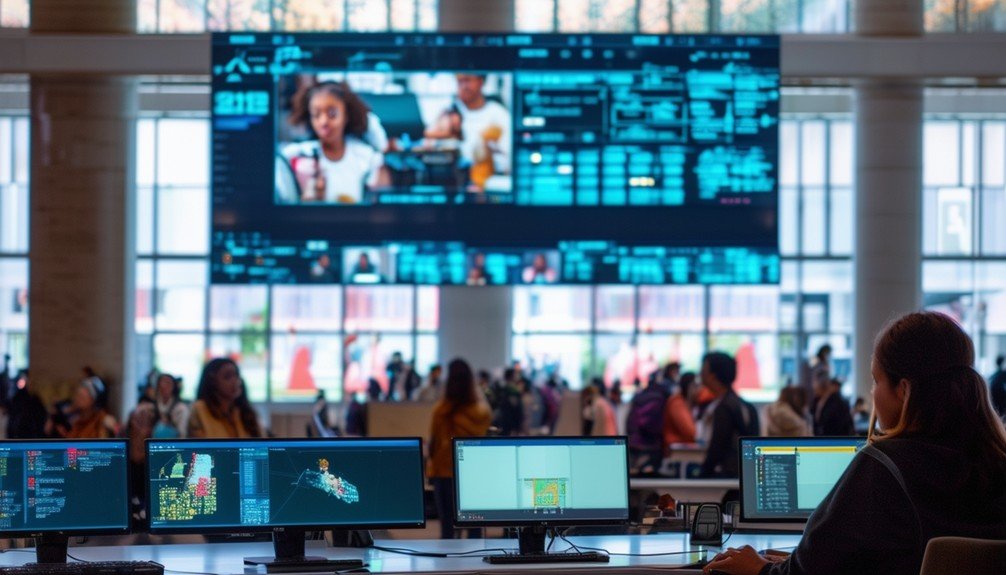
With a centralized control system, you can efficiently manage content across all digital screens in real-time. This system streamlines messaging distribution, ensuring timely updates for events, emergencies, and important announcements. Authorized users can make simultaneous updates, eliminating the need for manual changes and saving valuable time.
Efficient Content Management
A centralized management system allows administrators to efficiently oversee and update content across all campus digital screens simultaneously. With this system, you can handle content management effortlessly, ensuring that your campus network displays consistent, up-to-date information. Leveraging centralized oversight, you can push out real-time event updates swiftly, which is vital for effective event communication.
Here’s why a centralized management system is essential:
| Feature | Benefit |
|---|---|
| Centralized Management | Streamlines content oversight across the entire campus network. |
| Real-Time Event Updates | Guarantees immediate dissemination of event information and announcements. |
| Consistency in Messaging | Prevents outdated or conflicting information on different screens. |
| Enhanced Event Communication | Improves the effectiveness of campus-wide event announcements. |
| Ease of Use | Simplifies the process of updating multiple screens from a single location. |
Streamlined Messaging Distribution
Centralized control systems streamline messaging distribution, crucial all campus screens display consistent and timely event updates. By using a centralized system, you can push updates simultaneously to every digital screen across campus, maintaining uniformity and accuracy in campus-wide communication. This real-time capability means that whether it’s an emergency notification or an event promotion, you can manage and update information efficiently without delays.
One major advantage of centralized control systems is the elimination of manual interventions. With a few clicks, you can ensure that the latest event updates are broadcasted to all digital screens, saving you time and resources. This streamlined distribution process not only boosts operational efficiency but also enhances the overall communication strategy on campus.
Centralized control systems offer a reliable solution for managing critical information. In emergency scenarios, you can quickly disseminate essential instructions, crucial everyone’s informed and safe. For routine events, the system guarantees that promotional content reaches a wide audience in a timely manner. Integrating centralized control systems into your campus communication infrastructure means you’ll have a powerful tool to handle diverse messaging needs effectively, making campus-wide communication more robust and responsive.
Interactive Touchscreen Displays
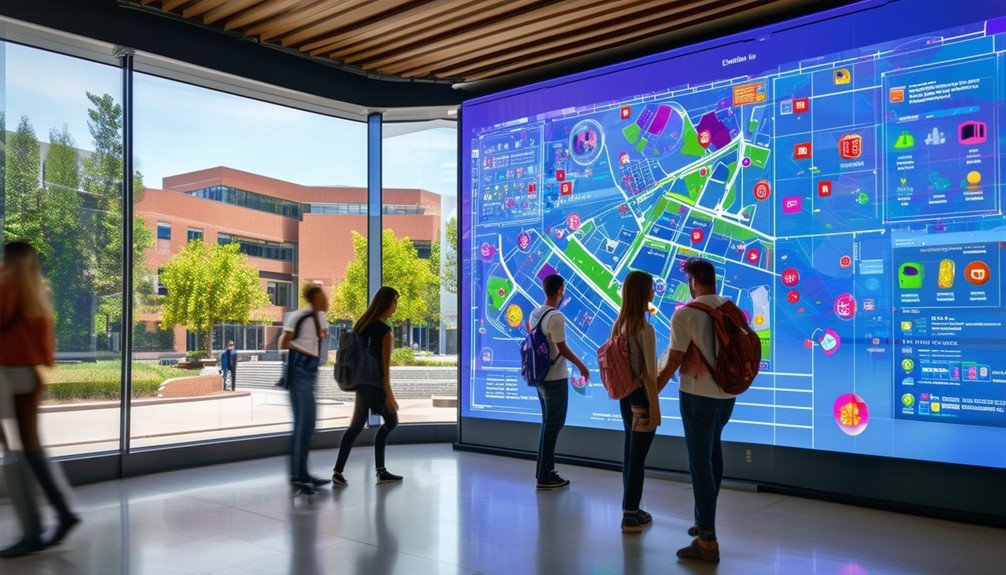
Interactive touchscreen displays allow students to actively engage with campus event updates, providing real-time information and enhancing overall participation. These displays are strategically placed around campus, making sure that you always have access to the latest updates. With just a tap, you can navigate through event calendars, interactive maps, and detailed event descriptions, making it easier to plan your schedule and never miss an important event.
By offering real-time information, interactive touchscreen displays keep you informed about changes or additions to the event lineup. This immediacy guarantees that you’re always in the loop, fostering increased student engagement. Whether you’re looking for the next club meeting, a guest lecture, or social gathering, these screens provide a thorough overview, eliminating the need to search multiple sources.
The hands-on nature of these displays makes the experience more engaging. You can quickly find what you’re looking for and even discover new events you might not have known about otherwise. The intuitive design and interactive features not only make information accessible but also encourage you to participate in campus activities, thereby enriching your overall college experience.
Emergency Notifications
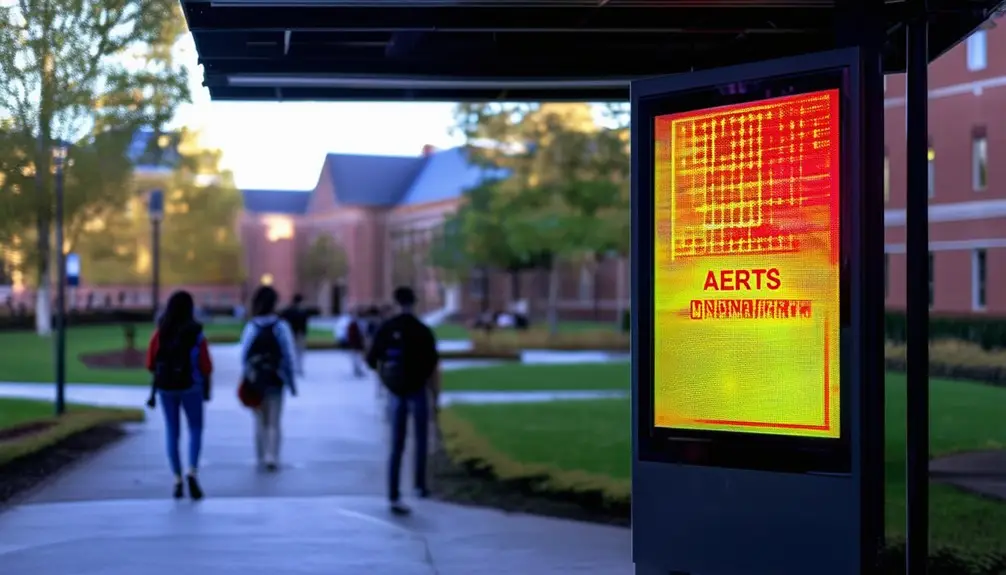
You can rely on digital screens for real-time emergency notifications, ensuring everyone on campus receives immediate safety updates. These screens integrate essential safety information, guiding you to the necessary resources during a crisis. Prioritizing quick responses and preparedness, emergency alerts on digital screens play an important role in keeping the campus community safe.
Real-Time Alert Systems
Real-time alert systems on digital screens ensure students and staff receive instant notifications during emergency situations, enhancing campus safety. When emergencies like severe weather, security threats, or other urgent situations arise, these systems guarantee that critical, time-sensitive information is disseminated swiftly. By leveraging digital screens placed throughout the campus, you can be confident that everyone stays informed and prepared.
These real-time alert systems are integrated with campus alert infrastructures, enabling rapid communication during crises. Whether it’s a tornado warning or an active shooter alert, the ability to push urgent information directly to digital screens means you’ll receive updates without delay. This immediacy helps prevent confusion and ensures that proper safety measures are followed.
Emergency notifications on digital screens inform and lead you to appropriate resources and safety tips. For instance, screens can display evacuation routes and procedures during a fire drill, ensuring orderly and safe exits. This level of preparedness greatly boosts overall campus safety and response efficiency.
In essence, real-time alert systems on digital screens are an indispensable tool in maintaining a secure and informed campus environment during emergencies.
Safety Information Integration
Building on the significance of real-time alert systems, integrating emergency notifications into digital screens guarantees rapid dissemination of crucial safety information during crises. These screens guarantee that everyone on campus receives timely and clear instructions, enhancing campus preparedness and response efficiency.
Emergency notifications on digital screens provide:
- Real-time safety information: Immediate updates keep students and staff informed about developing situations.
- Quick communication: Swift dissemination of alerts ensures that everyone knows what actions to take.
- Safety instructions: Guidance on evacuation procedures or shelter-in-place directives can be displayed instantaneously.
- Campus preparedness: Regular updates and drills can be promoted, ensuring the community is always ready.
- Safety tips: Helpful reminders on emergency awareness and precautionary measures can be shown regularly.
Immediate Emergency Response
Emergency notifications on digital screens play a vital role in guaranteeing swift and effective communication during campus crises. When an emergency arises, these screens can flash emergency alerts, providing urgent information that immediately captures attention. This rapid dissemination of information is essential for directing students, staff, and visitors to safe areas and proper resources, thereby enhancing overall campus safety.
By displaying safety measures and safety tips, digital screens help increase awareness and preparedness among the campus community. For example, during a fire or hazardous material spill, screens can offer step-by-step safety measures to follow, such as evacuation routes and shelter-in-place instructions. This instant guidance is invaluable in minimizing confusion and promoting orderly conduct in stressful situations.
Emergency notifications also serve as reminders of hazardous areas to avoid, reducing the risk of injury and further complications. Prominent placement of these notifications guarantees they are seen by the maximum number of people, making it easier for everyone to stay informed and act accordingly.
Sustainability and Eco-Friendly
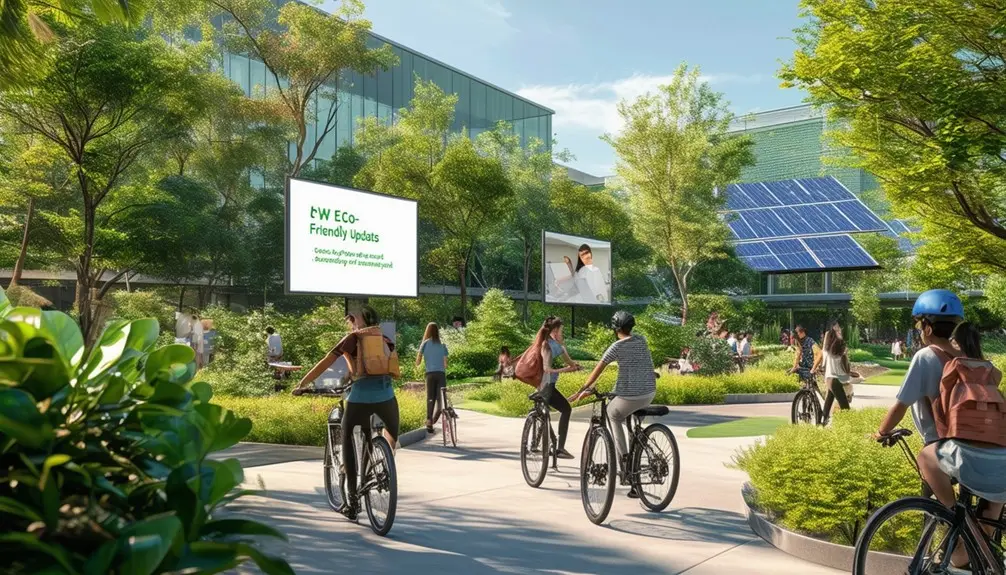
As campuses aim to reduce their carbon footprints, incorporating sustainability into everyday practices becomes essential for fostering an eco-friendly environment. Embracing sustainability in higher education not only enhances the campus environment but also sets a precedent for future generations. By prioritizing green initiatives, institutions can showcase their commitment to eco-friendly practices and inspire both students and staff.
To make a significant impact, consider the following sustainable practices:
- Integrate biophilic design: Use natural elements and sustainable materials in construction and renovation projects.
- Promote green initiatives: Encourage recycling, energy efficiency, and waste reduction programs across campus.
- Sustainable flooring: Choose eco-friendly flooring options that are both durable and environmentally responsible.
- Digital communication: Utilize digital screens for event updates to minimize paper waste and reduce carbon footprints.
- Community engagement: Involve students and staff in sustainability efforts, fostering a culture of environmental consciousness.
Incorporating these practices into your campus operations not only helps reduce your environmental impact but also positions your institution as a leader in sustainability within higher education. By adopting these green initiatives, you contribute to a healthier, more sustainable campus environment for everyone.
Wayfinding and Navigation
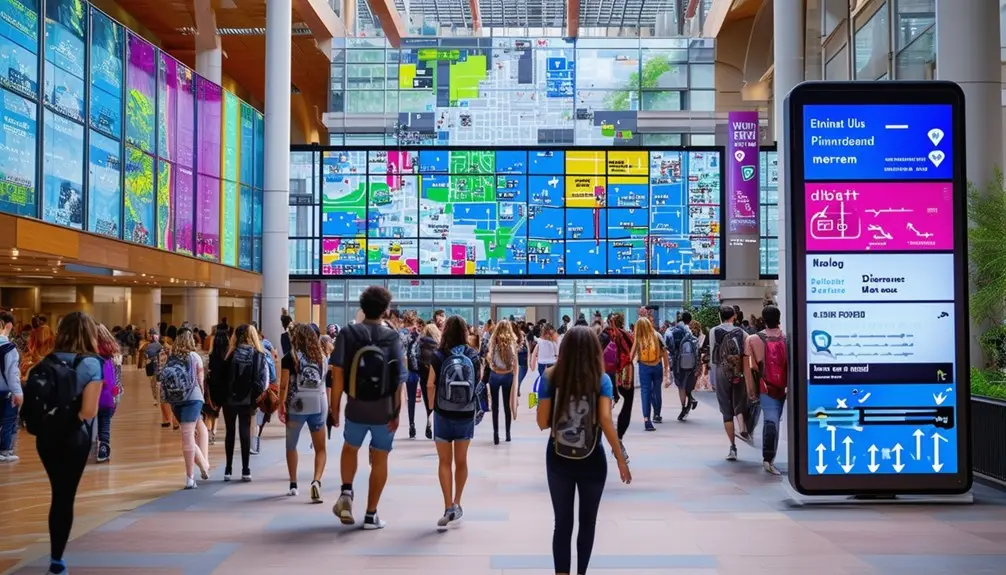
Leveraging digital screens for campus-wide event updates not only supports sustainability but also greatly enhances wayfinding and navigation for students and visitors. Interactive digital screens with touchscreen capabilities provide an efficient and user-friendly way to navigate large college campuses. As a student, you can easily find your way around using real-time updates that ensure you have the most current information on event locations and directions.
Outdoor digital signage placed in key locations offers weather-resistant navigation assistance, making it easier for everyone to move around the campus, irrespective of the weather conditions. With integration capabilities for tools like Excel and Google Sheets, campus maps and navigation data can be updated seamlessly, providing accurate and timely information.
These digital screens are more than just static displays; they are interactive hubs that allow you to engage directly with the information. You can pinpoint your exact location, plan the best route to your destination, and even find alternative paths if needed. This level of real-time, interactive wayfinding significantly reduces the time spent searching for locations and minimizes confusion, making your campus experience smoother and more efficient.
Boosting Campus Engagement
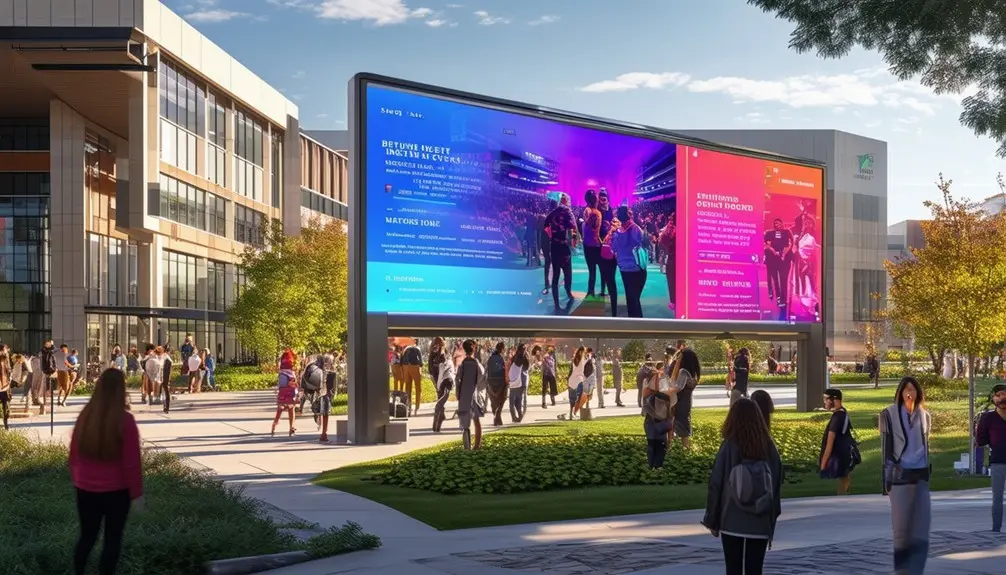
Digital screens on campus greatly boost engagement by capturing attention with dynamic, eye-catching content. These screens are far more effective than static media, boasting 400% more views, which means your event updates won’t go unnoticed. By displaying real-time calendar updates, they guarantee higher attendance and participation in campus events.
Here’s how digital screens enhance engagement:
- Increased Views: Digital screens capture more attention compared to traditional posters or flyers.
- Better Recall: The dynamic content improves recall rates, making sure students remember upcoming events.
- Real-Time Updates: Immediate changes to event schedules can be made, reducing confusion and improving the overall experience.
- Safety Measures: Emergency notifications can be flashed during urgent situations, ensuring student safety and awareness.
- Higher Participation: Real-time updates and eye-catching displays naturally lead to higher participation in events.
Role-Based Permissions
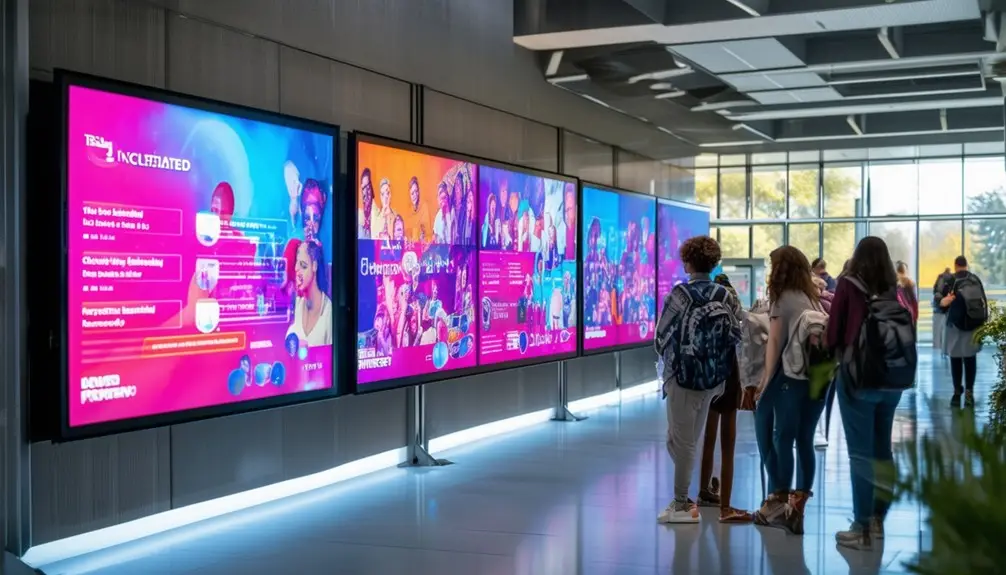
Role-based permissions guarantee that only authorized users can manage digital screen content, maintaining both security and consistency. By assigning specific user roles, you can control who has the ability to publish, edit, or manage content. Marketing teams, for instance, can be granted permissions to publish promotional content, while facilities staff can be given access to add emergency alerts. This granular control over content management ensures that each team can focus on its specialized tasks without overstepping boundaries.
Implementing proper approval workflows is essential for maintaining brand consistency and messaging accuracy. By integrating subject matter experts and approvers into the workflow, you make sure that all content aligns with the campus’s branding guidelines before going live. This process helps eliminate errors and guarantees that only high-quality, on-brand messages reach your audience.
IT departments can streamline operations by having access solely for back-end device management. This separation of duties minimizes the risk of unauthorized content changes and keeps the system running smoothly. Role-based permissions offer a structured yet flexible approach to managing digital screen content, making sure that your campus communications are both effective and secure.
Conclusion
By leveraging real-time alerts, dynamic content, and interactive touchscreens, you’ll boost campus engagement to a large extent. The cloud-based management and centralized control system guarantee seamless updates, while role-based permissions keep everything secure. Plus, these digital screens support sustainability efforts and enhance wayfinding. Embrace this innovative approach to keep your campus informed and eco-friendly. You’ll see a noticeable improvement in communication and overall campus experience.
Frequently Asked Questions
How Do Digital Screens Work?
You manage digital screens using signage software. This software lets you schedule and customize content for different audiences and locations. Integration with event management systems guarantees real-time updates, while interactive features boost viewer engagement.
What Is a Campus-Wide Network?
A campus-wide network is a centralized system that controls digital displays across the campus. You can guarantee consistent communication and real-time updates and coordinate content seamlessly, enhancing engagement and wayfinding for everyone on campus.


